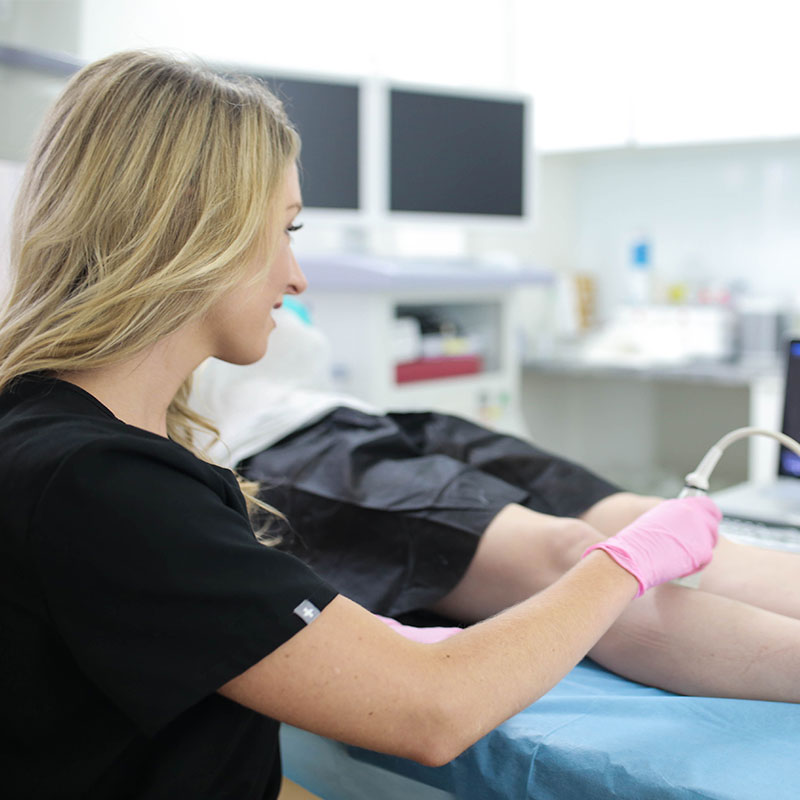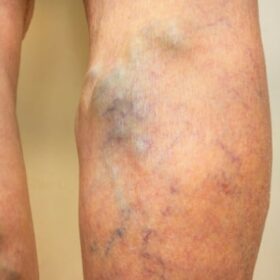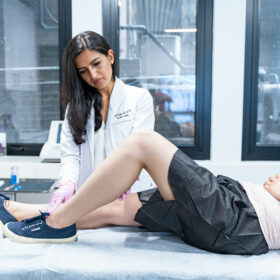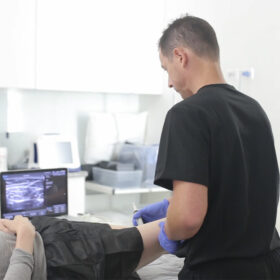Varicose veins, those twisted, bulging veins that often appear on the legs, can be more than just a cosmetic concern. If left untreated, varicose veins can lead to considerable leg pain, restless leg syndrome, leg heaviness, and leg cramps. Furthermore, varicose veins are often symptomatic of chronic venous insufficiency, a dangerous medical condition wherein collapsed vein valves fail to facilitate smooth blood flow to the heart, leading to blood accumulation in the leg veins. If this condition is allowed to worsen, you may suffer from leg ulcers, deep vein thrombosis, and other harmful complications. If you’ve noticed varicose veins on your legs, you’re right to be concerned. Below, we describe how you can handle the situation effectively.
1. Consult A Vein Specialist
The first and most crucial step is to consult a vein specialist, like the board-certified vein doctors at Vein Treatment Clinic. We have state-of-the-art locations across the United States, including New York, New Jersey, Long Island, California, and Washington DC. Our experienced vein specialists will evaluate your condition and provide a personalized treatment plan. Please schedule an appointment at your nearest vein treatment clinic to initiate your vein care journey.
You must consult vein doctors because they have the tools and experience necessary to identify the root cause of your vein problems and curate a personalized, comprehensive treatment plan. Some patients visit medical spas or dermatologists, but that’s a mistake — they may offer sclerotherapy or laser therapy for spider veins, but they can’t diagnose or treat underlying vein disease, so there’s a high risk of spider vein recurrence and other complications.
2. Diagnostic Ultrasound
At Vein Treatment Clinic, we always diagnose the root cause of spider veins and varicose veins via duplex ultrasound before curating a personalized treatment plan. This non-invasive imaging technique allows us to assess the blood flow in your veins and identify any underlying issues contributing to your varicose veins. During the duplex ultrasound scan, our vein doctors will use a transducer to emit sonic waves that provide a visual image of the direction of blood flow in your leg veins and any blockages, thus diagnosing underlying vein disease.
Benefits Of Duplex Ultrasound Test Before Vein Treatments:
- Non-invasive diagnostic tool
- Accurate assessment of blood flow
- Identifies underlying vein issues
- Guides personalized treatment plans
- Minimizes the need for exploratory procedures
- Real-time imaging capabilities
3. Lifestyle Modifications
Lifestyle changes aren’t solutions for vein problems. Once your vein valves are damaged, there’s no way to reverse the issue, so there’s no cure for vein disease. However, lifestyle changes can prevent the condition from worsening and help manage your symptoms. Our vein doctors will recommend a series of lifestyle modifications to alleviate the worst symptoms of vein disease and improve overall quality of life.
You can implement the following lifestyle changes to improve your symptoms:
- Exercise Regularly: Engage in low-impact exercises like walking and swimming to improve circulation in your legs. These exercises improve blood circulation and push some of the accumulated blood from your leg veins to the heart, minimizing discomfort.
- Maintain a Healthy Weight: If you’re overweight, shedding excess pounds can reduce the pressure on your leg veins. That’s because extra weight can place more pressure on your leg veins, thus increasing the risk of blood accumulation in the leg veins.
- Elevate Your Legs: When you’re resting, elevate your legs to encourage blood flow back to your heart. When you elevate your legs above your heart’s level while sitting or standing, gravity pushes some of the accumulated blood to the heart, alleviating some symptoms.
- Avoid Prolonged Sitting or Standing: Take breaks and change positions frequently if your job or activities involve prolonged periods of sitting or standing. If you continue sitting in one position for extended periods, gravity will push blood toward your legs, leading to blood accumulation in your leg veins, which, in turn, worsens your symptoms.
- Wear Compression Stockings: Compression stockings can help improve blood flow in your legs by applying pressure to the veins. They push some of the accumulated blood toward your heart, thus alleviating symptoms. However, you must consult our board-certified vein doctors to receive custom-fitted compression stockings.
4. Minimally Invasive Treatments
Depending on the severity of your varicose veins, your vein specialist may recommend minimally invasive treatments to improve the appearance of your legs. Minimally invasive vein treatments are the gold-standard for treatments because they are in-office procedures that conclude within an hour, cause minimal pain, and involve no hospitalization or downtime. You should only visit vein doctors that exclusively offer minimally invasive vein treatments.
Examples Of Minimally Invasive Vein Treatments:
- Sclerotherapy: Sclerotherapy involves injecting a solution into the affected veins, causing them to close and gradually fade from view. It’s a highly effective treatment for smaller varicose veins and spider veins, but it can’t treat underlying vein disease.
- Endovenous Laser Ablation (EVLA): EVLA is a minimally invasive procedure that uses laser energy to seal off the faulty vein, redirecting blood flow to healthier veins. It’s an excellent option for larger varicose veins and it involves little to no downtime.
- Radiofrequency Ablation: Similar to EVLA, radiofrequency ablation uses heat generated by radiofrequency energy to close the problematic vein, offering relief from varicose veins. This treatment can also treat underlying chronic venous insufficiency.
- VenaSeal: VenaSeal is a unique treatment that involves the use of a medical adhesive to seal the affected vein. It’s a comfortable and minimally invasive option.
- ClariVein: ClariVein combines mechanical agitation with a chemical solution to treat varicose veins effectively. It’s less painful than traditional treatments, and it’s especially suitable for extremely large, dilated, tortuous varicose veins.
- Ambulatory Phlebectomy: This procedure involves the removal of small varicose veins through tiny incisions. This procedure is suitable for superficial varicose veins, but it doesn’t treat underlying vein disease. It’s mostly a cosmetic procedure.
5. Follow-up Care
After undergoing treatment, it’s essential to follow your vein specialist’s recommendations for post-treatment care. This may include wearing compression stockings, taking prescribed medications, and attending follow-up appointments to monitor your progress. The following are some aftercare guidelines to improve results and minimize side effects:
- Wear compression stockings as prescribed.
- Take any prescribed medications as directed.
- Attend follow-up appointments as scheduled.
- Avoid prolonged sitting or standing.
- Engage in regular, low-impact exercise.
- Maintain a healthy weight.
- Elevate your legs when resting.
6. Maintain A Healthy Lifestyle
Even after treatment, it’s crucial to continue with a healthy lifestyle to prevent varicose veins from returning or getting worse. This includes regular exercise, maintaining a healthy weight, and practicing good leg hygiene. The following are some lifestyle modifications to maintain good vascular health and minimize the risk of vein disease recurrence:
- Incorporate regular exercise into your routine.
- Maintain a healthy weight.
- Elevate your legs during rest.
- Avoid prolonged periods of sitting or standing.
- Wear compression stockings if recommended.
- Stay hydrated.
- Follow a balanced diet.
- Avoid crossing your legs when sitting.
- Take short breaks to move and stretch.
Additional Information About Varicose Veins
What Are Varicose Veins?
Varicose veins are enlarged, twisted veins that often appear on the legs. They occur when the valves in your veins, which are responsible for preventing blood from flowing backward, become weak or damaged. When these valves fail to function properly, blood can pool in the veins, causing them to swell and become visible beneath the skin’s surface.
Risk Factors For Varicose Veins:
- Heredity: If your parents or grandparents had varicose veins, you may be genetically predisposed to the condition.
- Age: As you get older, the natural wear and tear on your veins can lead to weakened valves and, subsequently, varicose veins.
- Gender: Women are more likely than men to develop varicose veins, partly due to hormonal changes that can weaken vein walls during pregnancy and menopause.
- Prolonged Standing or Sitting: Jobs or activities that require long periods of standing or sitting can increase the pressure on your veins, making varicose veins more likely.
- Obesity: Excess weight places additional pressure on the veins in your legs, which can lead to varicose veins.
- Lack of Physical Activity: Regular exercise helps promote healthy blood flow. If you lead a sedentary lifestyle, you may be at a higher risk.
Symptoms of Varicose Veins:
- Pain: You may experience pain or discomfort in the legs after standing for long periods.
- Swelling: Your legs may become swollen, particularly around the ankles and feet.
- Itching and Burning: You may note itching or burning sensations near the affected veins.
- Heavy Feeling: Your legs might feel heavy and fatigued.
- Restlessness: Restless leg syndrome is often associated with varicose veins.
- Skin Changes: Skin near the affected veins can become discolored or develop open sores.
Health Problems Associated with Varicose Veins
- Blood Clots: Blood clots can form in varicose veins, which can be dangerous if they break free and travel to the lungs (pulmonary embolism) or other parts of the body.
- Ulcers: Untreated veins can cause skin ulcers, which are painful sores that are slow to heal.
- Bleeding: If a varicose vein ruptures, it can lead to significant bleeding.
- Superficial Thrombophlebitis: This is a condition in which the veins just beneath the skin become inflamed, causing pain and redness.
Visit Your Nearest Vein Treatment Clinic
Varicose veins are a common vascular condition that can have both cosmetic and medical implications. If you suspect you have varicose veins or have already been diagnosed with them, it’s essential to take action. Start by consulting a vein specialist at Vein Treatment Clinic, where we offer hassle-free insurance verification and have a team of board-certified vein doctors ready to help you. With early intervention, lifestyle modifications, and minimally invasive treatments, you can effectively manage varicose veins and enjoy healthier, pain-free legs.












